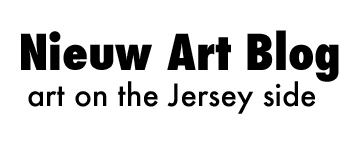11/15/17
What compels artists to painstakingly create alternate realities and spaces? At the exhibition Constructed Space, curated by Midori Yoshimoto, Ph. D., four artists specifically take on this quest with different approaches that are all fascinating and unique. With some of the work, the process is not immediately known, yet hints at something otherworldly, dreamlike and surreal, while other works lay it all out deliberately and concretely. Regardless, this exhibition forces us to pause and wonder about the spaces we create as humans, while addressing the desire to re-create and manipulate them.
Curt Ikens’ work is one which invites the viewer into his process- all layers of it. One of the pieces “Platform for a Skeptical Constituency” is on the floor and built into the corner. The outer edges show the bottom plywood, then the unstained wooden planks on top, which slowly become fully stained and more organized and even contain some inlaid detail toward the corner. I really enjoyed this visual experience which isolates each component while also working as one piece. Another piece (pictured below) “Figments of Forefathers”, takes a big square of flooring and hangs it as an object. The organic shape reminded me of a wooden quilt. Instead of stitching, we see his hand with stain swipes, and an irregular joining of the wood. In other works, he has scratched in color which suggests a primitive scrawl that one would find when an errant child found a crayon. Ikens' relationship with wood is authentic and palpable- he honors the structure of the wood and is also compelled to dismantle it.
Kim Keever’s work is completely the opposite in approach. His dreamy landscapes and spaces make us wonder exactly where this place is- when in fact it exists nowhere other than here. There is a removed quality to the work– as if we are viewing it through a decidedly murky lens. Keever’s process is opaque and one would not guess it without explanation. These are not “real” landscapes at all; they are totally artificial detailed miniature scenes submerged in a 200-gallon water tank and then photographed. Even knowing this information, I struggled to see them as “unreal”. This work really provokes us into thinking about illusion, realities and actuality. In “Blue Delta” (below), we are taken down the “river” and through the “hills” while looking at a majestic glowing “sky”. Keever creates his own personal and ethereal world that has never existed until now, and by doing so, challenges us to think about landscape and its definition.
Martin Kruck "Cell"
Martin Kruck’s work plays with space. He juxtaposes an image with a location which, when viewed together, create an unexpected interior. Unlike Keever’s work, Kruck's locations do exist in reality- he reinvents and manipulates them into a whole new space. His art examines that initial space and alters it by adding in elements that play off each other resulting in a whole new perspective. In “Savoy”, he places a classical sculpture in a medical examining room for great apes. The grid tiled room is accentuated with the presence of the sculpture that stands over a cement slab. A twinkling dust-like material is in the atmosphere; giving this stark composition a hint of surreal magic. In “Cell” (pictured below), Kruck uses formal elements simply and effectively. The rough texture of the enclosed space envelopes the billowy cloud. The white geometric opening counters with the ethereal puff, while balancing the shadow at the bottom. Here we have heavy vs. light, and open, yet enclosed. Kruck plays with a space that on its own looks uninviting and grim, and then transforms it with the visiting cloud which simply hovers there as a hopeful intruder, bringing air and lightness to an otherwise claustrophobic, empty existence.
Jeremy Coleman Smith “Cross Section: Bottom Shelf”
Jeremy Coleman Smith’s work offers a domestic narrative. Smith recreates and elevates mundane scenes out of man-made materials, such as cardboard, paper and foam-core. These materials are usually of little value, but they ultimately assume the qualities of the original objects. By having all components fabricated in this manner, Smith invites the viewer to think about what these scenes or objects can mean, rather than what they are. The reality of the object is removed, stripped away, thus forcing us to ponder their significance or rather the significance we ourselves assign to them. In “Cross Section: Bottom Shelf”, Smith recreates a kitchen sink area. Upon close inspection, we see the sink is paper with the paper seams in view– a purposeful reveal of the hand-made. We also notice that he pays attention to detail by simulating the textures on the paper rubber glove and sponge in the sink. On the bare counter sits a wine bottle-shaped ceramic piece, and above that is, perhaps, a half-drunk glass of wine strategically perched on a window ledge. This is where it gets intriguing, as the artist leads us through the slightly obscured glass to a marsh-like, mysteriously lit landscape, which transports us out of the interior and into what lies beyond the mundane.
Constructed Space, 10/24/17 - 11/29/17. The Harold B. Lemmerman Gallery, New Jersey City University, features work by Curt Ikens, Kim Keever, Martin Kruck and Jeremy Coleman Smith. The exhibit is curated by Midori Yoshimoto, Ph.D.
Constructed Space, 10/24/17 - 11/29/17. The Harold B. Lemmerman Gallery, New Jersey City University, features work by Curt Ikens, Kim Keever, Martin Kruck and Jeremy Coleman Smith. The exhibit is curated by Midori Yoshimoto, Ph.D.

























